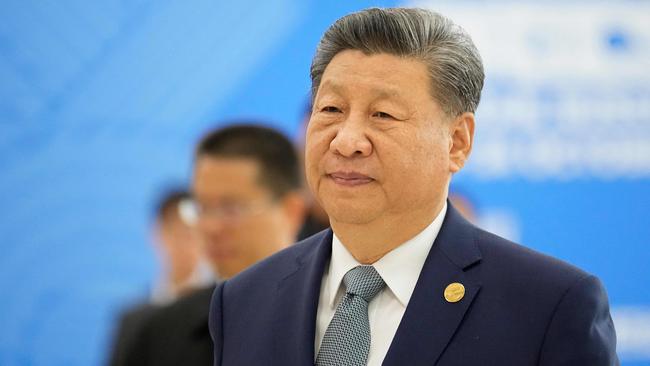China builds port in America’s backyard
Peru will it will take centre stage next month in a revolution of the world order.

The coastal town of Chancay in Peru was once known for little more than its pre-Hispanic Inca culture.
It served as a tourist resort for residents of the nearby capital, Lima, who liked to visit its 19th-century mock medieval castle. But from next month, when Chinese President Xi Jinping’s cavalcade arrives, it will take centre stage in a revolution of the world order.
The peace of Chancay has been disturbed by the construction of a $US3.6m megaport, the first on South America’s Pacific coastline large enough to take the world’s biggest container ships.
Peru hopes it will open a fast, direct line not only for itself but for neighbours such as Brazil to Asia’s factories. It will cut the need for transfers via Mexico and the US, giving China a deepwater port on the Pacific’s eastern rim – in America’s backyard – and control of the continent’s key trade route.
China hopes the same. It is one big reason why one of its state-owned companies not only built the port but won exclusive rights to operate it.
“Peru will become China’s port hub in South America, which will upset US interests,” wrote Lieutenant Colonel Manolo Eduardo Villagra, a strategist with the Peruvian army, last year.
His conclusion? Peru should start strengthening its military forces, he said, as the country, not long ago torn apart by civil war and political instability, suddenly becomes a key point between rival powers.
Chancay is not the largest investment to derive from Mr Xi’s legacy project, the Belt and Road Initiative, under which Beijing funds infrastructure in developing and middle-ranking countries to tie them into China’s trade and political orbits.
It has, however, become one of its most controversial. It appeared to be a straightforward commercial enterprise, in which a company owned 60 per cent by Cosco, China’s biggest state-owned port and shipping company, and 40 per cent by Volcan, a Peruvian mining company, would build a gateway to the Pacific. Peru, and hopefully other parts of Latin America, would then export minerals and food such as soya beans to China and the rest of Asia, and import consumer goods.
The Peruvian government woke late to the fact that the construction contract also gave Cosco exclusive rights to run the port, breaching a policy that all ports must be run by the state.
That rang alarm bells in Washington. All Chinese companies, particularly state-owned ones, are legally bound to accede to Beijing’s security demands and the People’s Liberation Army in times of crisis such as a war with the US.
That could, in theory, turn Chancay into a Chinese naval base. “The PRC (People’s Republic of China) is playing the long game with its development of dual-use sites and facilities throughout the region,” General Laura Richardson, head of US Southern Command, told a congressional committee this year.
Washington has only itself to blame. Mr Xi has made repeated visits to Latin America in his 12 years in power and Chinese companies have poured in investment cash, particularly in mines that will be key to new technology. They own stakes in lithium production, a key component of batteries, in Argentina, Bolivia and Chile.
And in Peru, China controls the companies that between them provide all the electricity to the capital.
America, by contrast, has shown little interest. President Joe Biden has not visited South America, and former president Donald Trump spent only three days there at a meeting in Argentina. American companies have followed their presidents’ lead, often citing the region’s political instability, which China generally ignores.
When the Peruvian authorities decided to build another port further south for mineral exports, the only bidders this year were Chinese.
“Public opinion in Peru might want to criticise China politically,” Omar Narrea, an academic at the University of the Pacific, in Lima, said. “But it’s not just about the politics, it’s about the economics too.”
The US is now trying to catch up, in part in response to warnings by generals such as Richardson.
Mr Xi’s inauguration of Chancay will take place on the sidelines of an Asia-Pacific Economic Co-operation summit in Lima, which Mr Biden is also due to attend. Both men will also visit Brazil as a battle for influence continues.
However, China is winning the race there, too. Brazil is a major supplier of soya beans, sugar and other foods to China, which overtook the US to become its biggest trading partner in 2009. President Luiz Inacio Lula da Silva has forged close relations with Mr Xi, in part through the BRICS group of emerging economies.
The two countries recently devised their own peace proposals for the Ukraine war. “The China-Brazil partnership has developed beyond the level of trade,” said Rebecca Nadin, an expert on China’s investment strategy and the BRI at the Overseas Development Institute.
The success of the Chancay port does face challenges, such as whether countries such as Brazil can overcome the environmental and technical obstacles to the new road and rail links that will make it truly profitable.
America is banking on Latin America’s ordinary voters deciding in the long run that they would rather stay in the orbit of their closer and freer neighbour than the more alien China.
But Beijing is also playing down the notion of becoming a global challenger to the US with developments such as Chancay. An editorial this week in the Global Times, a Communist Party mouthpiece, said the port showed there could be “synergy” between American and Chinese investment in places such as Peru, for the benefit of everybody.
The Times



To join the conversation, please log in. Don't have an account? Register
Join the conversation, you are commenting as Logout